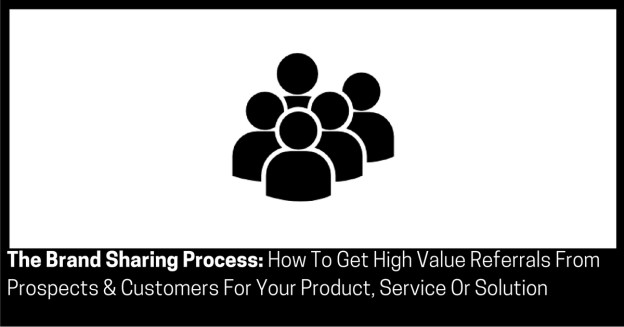Approximate read time: 21 minutes
We have recently seen a flood of new products, services, solutions and subsequent marketing messages (even the human body can be used as a billboard now).
But, attention is scarce and limited – prospects and customers can’t digest it all, and they distrust a lot of it.
They see on average 362 marketing messages per day.
That is approximately 100,000 marketing messages per year!
It’s impossible to take all of that information in and process it.
“Ad blockers” are on the rise to combat this situation to filter out irrelevant messages, particularly those that are marketing messages.
Cognitive psychologist George A. Miller said the human mind can only hold on average seven individual units of information in working memory at once.
99% of these messages will be missed by prospects and customers.
So, unless your marketing message stands out, as you can probably guess, it will be lost forever.
This means referrals are important for your brand for many reasons.
Ultimately, the purpose of referrals is to get new customers, or at least new prospects.
Referrals allow your brand to get more leads (prospects, AKA opt-ins) and sales (customers) for free from a trusted third party without having to acquire them through other sources.
This social proof from the referring party makes the connection to your brand stronger.
Social Proof is powerful.
Robert Caidini wrote about it in his book, Influence: The Psychology of Persuasion. “People will do things that they see other people doing.”
In this case, it is followed and engaged on social media, if others are doing the same.
This trusted third party most likely knows and likes your brand and, therefore, is potentially more honest about the brand than the brand itself, as the third party has no self-interested motive.
If fact, the referring party has a lot at stake – they are putting their personal reputation with their friend on the line, so they need to be very confident about the referral which makes it even more powerful as an acquisition tool for your brand.
Prospects are more open to hear what their friends say about a brand.
Referrals allow your customers to feel good about their purchase and valuable in the eyes of the referring friend.
Referrals help your brand get its message out by educating new prospects and customers through pre-framing and pre-selling.
These trusted third parties are usually, happy, satisfied clients who already know, understand, and appreciate what you offer.
According to a study by the Goethe University Frankfurt and the University of Pennsylvania, referred customers are “more profitable and loyal than normal customers” and contribute to high retention and profit margins, both short and long-term.
So, let’s define some terms.
Sharing is giving something to another.
Sharing an experience is enjoying an experience with or giving an experience to someone.
A referral is when a person, not necessarily a current prospect or customer, makes a recommendation to someone they know, possibly without the third party’s knowledge.
A referral is a specific type of sharing.
A marketing or sales referral is a way of promoting products, services, or solutions to new prospects and customers through a third party.
This is usually done through word of mouth.
Word-of-mouth is the communication of information through spoken or written language, either live or recorded.
A non-commercial communicator (i.e. someone who is not rewarded) and a receiver concerning a brand, a product, or a service.
This is also known as buzz, blog, viral, grass roots, brand advocates, cause influencers, social media marketing, ambassador programs, Grapevine, bush telegraph, lecture circuit, preaching and so on.
A partnership or joint venture is where two or more parties take part in an undertaking, association, or arrangement to work together to share risk and profit.
A partnership or joint venture in marketing, amongst other things, is about working together to promote each other’s products, services, or solutions for increased mutual profit and reduced risk.
An affiliate or sub-promoter is a party that is officially attached to a vendor.
An affiliate or sub-promoter in marketing is where the affiliate gets paid for making referrals, leads or sales for a vendor’s product, service, or solution.
A vendor, merchant, retailer, advertiser or seller is a provider that offers products, services or solutions for sale.
Sharing Types
There are various types of sharing.
One-way and two-way sharing.
We’ll only concentrate on one-way sharing for this guide, as two-way sharing relates to partnerships.
Organic & Proactive (Intentional & Unintentional)
One-way promotions could be organic or proactive (encouraged or spontaneous—referrals, respectively, could be intentional or unintentional).
In the first instance, you hope new prospects and customers will refer more new prospects and customers.
In other words, they are unintentional.
In the second instance, you put in place a system that is effective, predictable, and consistent so that new customers can refer new prospects.
In other words, they are intentional.
You can’t affect the organic referrals, so we will concentrate on the latter in this guide, which you can affect.
Non-incentivised & Incentivised
One-way promotions could also be non-incentivised or incentivised.
In the first instance, you ask customers just after they have purchased to refer new prospects.
In other words, there is no incentive to share.
In the second instance, you set up the equivalent of an affiliate program where you offer your customers just after they have purchased (and, in some instances, current prospects) an incentive to refer new prospects.
In other words, there is an incentive to share.
Even if you don’t offer an affiliate program to customers just after they purchase, you can still offer it later on.
These are very valuable…
According to the same study by the Goethe University Frankfurt and the University of Pennsylvania on referral customers, even when taking into account a referral cost, the related retention time and profit margins are outweighed.
We will concentrate on both types in this guide.
You & They Contact
One-way promotions could also be where your brand does the referral contact or your prospects and customers do the referral contact.
In the first instance, you ask prospects and customers for contact details for new prospects and customers so you can contact as the referral.
In other words, your brand is the contact point.
In the second instance, you ask your prospects and customers to contact new prospects and customers as the referral.
In other words, your prospects and customers are the contact point.
We will concentrate on both in this guide.
Linear & Viral
One-way promotions could also be linear or viral.
In the first instance, linear sharing is sharing that spreads proportionally.
In other words, one customer refers another new customer only.
In the second instance, viral sharing is sharing that spreads disproportionally.
In other words, one customer refers more than one new customer.
Here is how it works…
A virus is an infectious agent that replicates itself in the cells of a host organism.
Viruses are not cellular so they do not grow through cell division, sexually or asexually.
Viral replication.
Viral sharing occurs when.
Virus invests more than one.
Viral growth requires the viral coefficient to be greater than 1.
K>1
Anything below that is linear growth.
The viral coefficient is the average number of referrals (invitation rate) invitations multiplied by the conversion (acceptance rate) of the new user.
The equation would look like this:
Viral coefficient = invitation rate * acceptance rate
Or:
K=1*conversion%
The Invitation rate is the number of referral current customers sent.
The acceptance rate is the number of new customers per number of referral current customers sent.
Let’s look at example:
You have 100 customers.
And each customer sends 2 invites each or 200 total invites.
The Invitation Rate is 2 (total invites divided by customers).
Now let’s say out of the 200 total invites sent, 110 new prospects or customers are created.
This means the Acceptance Rate of the invitations is 0.55 (new prospects or customers are created divided by total invites sent).
The viral coefficient is 1.1 (Acceptance Rate multiplied by Invitation Rate).
As 1.1 is greater than 1, you have achieved viral referrals.
Congrats.
That’s a hard thing to do!
This guide will concentrate on both linear and viral sharing.
Sharing Motivation
So, why do people share?
There are 11 main reasons people share:
- To look good (brag) in front of friends and improve their standing;
- To help and add value to friends;
- To inform, inspire, entertain, change opinions or encourage action;
- To maintain, reconnect with friends, and grow relationships;
- To connect with people they normally would not;
- To self-fulfil and get involved with the world;
- To help learn and process new information;
- To define their identity to themselves and others;
- To feel connected;
- To support your brand;
- To support issues and causes they are passionate about;
- And many others…
Although incentivised referrals are great, when money is involved as the incentive, it can make the referral transactionary, and it appeals to a different motivation, that is #13—financial gain!
This means when you want a referral to your brand, you need to appeal to one of more of these reasons.
Number 2 and 3 are deposits.
Stephen Covey explained a concept called the Emotional Bank Account in his book The 7 Habits of Highly Effective People.
The concept describes how building trust works in human interactions.
It is analogous to a bank account where deposits and withdrawals of money can be given and taken.
If a bank account gets filled, it can lead to more trust, and likewise, if it gets overdrawn, it can lead to a diminishing of trust.
The same principle applies to marketing and sales.
And we know marketing and sales only happen when prospects and customers know, like, and trust your business.
Selling is about relationships, even if you don’t know prospects and customers personally.
Relationships here are defined as the way in which a market and a business are connected.
And relationships should be mutually beneficial so that the sum is bigger than the individual parts.
This is about delivering value.
Relationships are like bank accounts that contain currencies, in this case money and having their problem solved, and has deposits and withdrawals of either of those currencies.
As a referrer, your customers may want to build a reserve of credit with their friends to draw upon in the future.
They don’t want to overdraw their account.
Some people know this instinctually.
Old deposits evaporate, so keep making deposits.
In other words, referrals can fill the “value account” with deposits of value before they make a withdrawal.
This is what I mean by giving and take – deposits and withdraws.
But there is no need to micro-manage this process and keep tallies on who has done what.
This is about the overall balance and sense of deposit and withdraw ratio.
It’s always best to err on the side of giving too many deposits.
When we support a friend or “like” what they do, we maintain that relationship and reinforce closeness.
Shared Content Types
Therefore based on why people share, here is a list of what types of things get shared:
- Insider or superior content, knowledge, results or outcomes
- Insider or superior content, knowledge, results or outcomes
- Informational, inspiring or entertaining content, knowledge, results or outcomes
- Content, knowledge, results or outcomes that give a customer a reason to contact a friend
- Content, knowledge, results or outcomes that give a customer a reason to contact someone new
- Content, knowledge, results or outcomes that aligns with a customer’s world view or help them be more social
- Content, knowledge, results or outcomes that are informational, inspiring or entertaining
- Content, knowledge, results or outcomes that aligns with a customer’s world view
- Content, knowledge, results or outcomes that helps a customer be more social
- Content, knowledge, results or outcomes that allows customers to show gratitude towards your brand
- Content, knowledge, results or outcomes that aligns with a customer’s world view
- And many others…
The Elements
So, what are the steps for getting proactive, liner, or viral, incentivised or non-incentivised, you-contact or they-contact referrals?
Here they are:
- STEP 1: Referral Timing;
- STEP 2: Referral Location; and
- STEP 3: Referral Request.
Let’s begin with…

1) Referral Timing
…This step is about the timing of asking for a referral.
So, when do you ask for a referral?
There is a sales saying that goes like this: “When the emotion is high, ask to buy.”
High emotions are the best time to ask to buy, and after they have bought their emotions are still high, so the ideal time to share is at purchase.
They are excited for results and pleased with their purchase.
The excitement actually comes from dopamine.
There is a gap between the time of purchase and when they get the result.
This gap in time can also increase dopamine, one of the most addictive, naturally occurring human hormones!
Dopamine can be created by the expectation of new experiences (in this case, the outcome from the new purchase.)
The gap between the time of purchase and when they get the result comes from the following:
Customers purchase products, services or solutions when they want to move away from their current situation or, towards a new situation – away from pain or towards pleasure, ideally in the fastest way possible.
Your product, service or solution is actually a barrier to moving customers away from pain or towards pleasure.
Think about it this way, the most direct path for a customer would be a short two-step path:
- Current situation (pain); then
- New situation (pleasure).
With your product, service or solution, the path for a customer is actually a longer three-step path:
- Current situation;
- Your product, service or solution; then
- New situation.
This is the reason humans want magic-pills or silver-bullet products, services or solutions, and they want results yesterday!
Magic-pills or silver-bullets rarely exist, so you need to sell people what they want (two-step path), but you also have to give them what they need (three-step path).
The more you can speed up or automate your product, service or solution, the better.
You want to reduce the time and effort it takes to move from Step 1 to Step 3 to a minimum.
The faster or simpler you can move a customer away from pain or towards pleasure, the more value you add to them, and the more you can charge for doing so via your product, service or solution.
Directly after a purchase is one of the best times to ask for a referral because it reassures the purchaser it was a good purchase (choice), so they don’t have buyer’s remorse.
In fact, asking for a referral at this time reduces buyer’s remorse because they have now justified the purchase to another.
This is called Confabulation.
Confabulation is where we create a story and rationalize with logic after the fact.
It also the “Commitment and Consistency” principle of influence from Robert Caidini’s book Influence: The Psychology of Persuasion.
The Commitment and Consistency principle says “we feel we must always align our outer actions and promises with our inner choices and systems, such as our beliefs and values.”
Buyer’s remorse is the feeling of regret in a buyer after they have made purchases.
It usually occurs with a core purchase rather than an impulse purchase, such as low-priced offers.
The feeling of regret could be associated with the fear of making the wrong choice, guilt over extravagance, or a suspicion of having being overtly influenced by the seller, and so on.
It is also okay to ask for referrals any time a customer is in a mood to give one.
But having said that, it varies wildly and is unpredictable so stick with time of purchase as buyer’s remorse will not have set in.
Of course, the exact details of how to do this are beyond the scope of this guide.
This step is about Referral Timing.
This leads us to the Referral Location step…

Might be good better adjusted further
2) Referral Location
…This step is about the location to ask for a referral.
Once you know when to ask for a referral, now you need to know where to ask for the referral.
So, where do you ask for a referral?
At any touch point, which could be everything from:
- Website;
- Advertising;
- Publicity;
- Content;
- Messages;
- Storytelling;
- Marketing Communication;
- Sales Communication;
- Product, Service Or Solution Delivery;
- User Experience;
- After Sales Customer Service;
- And so on…
And it can be any sense your prospects and customers use to interface with and perceive your brand.
The way they:
- Hear your brand;
- See your brand;
- Smell your brand;
- Touch your brand; and
- Taste your brand…
Of course, the exact details of how to do this are beyond the scope of this guide.
This step is about Referral Location.
This leads us to the Referral Request step…

3) Referral Request
…This step is about requesting the referral.
Once you know where to ask for a referral, now you need to ask for the referral.
So, what do you ask when requesting a referral?
There are two main things you want your customers to share or refer:
- Any content communication; and
- Any sales communication.
Now that you know what you want your customers to share, here is what you should be asking them to do.
Organic & Proactive (Intentional & Unintentional)
If you are aiming for organic shares, the main thing you want to do is appeal to each motivation described previously.
Remember, you hope new prospects and customers refer more new prospects and customers.
Again, 11 main reasons people share are:
- To look good (brag) in front of friends and improve their standing;
- To help and add value to friends;
- To inform, inspire, entertain, change opinions or encourage action;
- To maintain, reconnect with friends, and grow relationships;
- To connect with people they normally would not;
- To self-fulfil and get involved with the world;
- To help learn and process new information;
- To define their identity to themselves and others;
- To feel connected;
- To support your brand;
- To support issues and causes they are passionate about;
- And many others…
Now if you are aiming for proactive shares, you want to appeal to certain motivations described previously.
These are helping your prospects and customers share something useful or an incentive
Non-incentivised & Incentivised
If you are looking for incentivised sharing, you want to:
- Allow both the referrer and referee to both get gifts or value from the referral; and
- Make them in voucher or coupon form so they are encouraged to spend to redeem.
If you are looking for non-incentivised sharing there is not a whole lot you can do.
You & They Contact
If you want to contact new referral prospects and customers on behalf of current prospects and customer, you want to:
- Ask current prospects and customers for names and contact details of new prospects and customers and share something about your brand.
Make this information easy to give you, but be wary of spam.
You can read the Spam Act 2003 here: http://www.comlaw.gov.au/Series/C2004A01214.
NOTE: What follows is not legal advice.
In essence, you need:
- Gained consent for commercial communication;
- Clear identification of who sent the communication; and
- The ability to stop any further the communication.
Here are some guidelines that may help you comply:
- All links, phone numbers or contact information in the message should be intended to identify you by being placed in the signature and do not lead to content with a commercial purpose;
- Only find email addresses that are publicly published. Don’t guess email addresses or harvest them. Don’t contact emails that say they don’t want to be contacted publicly;
- Publish your business name, address, website, phone number and email in the email signature for the sole purpose of identifying the sender of the message, and make sure they do not lead to content with a commercial purpose. Staff should use their name both in the body and field;
- Your email address should stay active for 30 days after ceasing contact;
- Have unsubscribed information in the P.S. of email. Do this because the P.S. section is the one of the most read parts of an email;
- Remove unsubscribes immediately; and
- Unsubscribing needs to be free for the recipient.
Your electronic communication is about contacting the decision-maker with free value to open up a conversation and relationship with them, and offering to compensate them, not advertising a product, service or solution for sale.
If you want your current prospects and customers to contact new referral prospects and customers on your behalf, you want to:
- Ask current prospects and customers to contact new prospects and customers and share something about your brand.
Linear & Viral
If you are looking for linear sharing, ask prospects and customers to share with one friend and you want to appeal to:
- Anything practical or useful;
- The positive, rather than the negative.
Now if you are looking for viral sharing, you want to ask prospects and customers to share with at least one friend and appeal to topics such as:
- Interest;
- Newness;
- Uniqueness and difference;
- Humour; and
- Speculation.
- To name a select few…
Or the more negative topics:
- Controversy;
- Conflict;
- Rumour;
- Scandal; and
- Sensationalism.
- To name a select few…
This content generally evokes strong emotions in people because it challenges or offends people’s behaviour, beliefs or belongings according to author Tim Ferriss.
These emotions may include:
- Shock;
- Affinity;
- Intrigue;
- Enjoyment;
- Titillation;
- Arousal;
- Confusion;
- Excitement;
- Interest; and
- Remarkable.
- To name a select few…
Or the more negative emotions:
- Hate;
- Disgust;
- Outrage; and
- Anger.
- To name a select few…
It’s unfortunate that these topics of content and related emotions appeal to humans, but they are what people generally want to consume, as they are primal, deeply embedded emotions in the human psyche.
They are “valuable” content.
All of this means your brands stands out in its content.
I suggest you steer clear of the negative topics and emotions and focus on the positive.
These emotions usually evoke and pique interest, and compel an urge to engage, spread and pass the content along through social networks through the various mechanisms as discussed previously:
- To click on content sales scripts;
- To view or download content;
- To like content;
- To vote (a form of liking) on content;
- To comment on content;
- To review content;
- To react or respond to content;
- To share content;
- And so on…
These actions could be achieved by the following types of content that are easy to consume:
- Lists
- Best-of’s;
- Demonstrations;
- How-to’s;
- Quizzes;
- Quotes;
- Memes;
- Slideshows;
- Images;
- Infographics;
- Animated Gifs;
- Exclusives;
- And so on…
And the more negative types:
- Leaks;
- Risqué advertisements;
- Misleading headlines;
- Making things up;
- And so on…
This content could be communicated through a range of content modalities:
- Text;
- Image;
- Video;
- Audio;
- And so on…
The content needs to be related to your brand but not necessarily your products, services or solutions specifically.
This step is about Referral Requests.
Of course, the exact details of how to do this are beyond the scope of this guide.

Take Action
You made it…
You now have a solid plan for getting high value referrals for your product, service or solution.
That’s the full Brand Sharing Process, and it will be more than enough for you to get started on your own.
You can get the printed illustrated Process Map of this and 20 others for free, here
And if you’re serious about marketing and selling more, the logical next step is to contact me to help you do it yourself, have me do it with you, or have it all done for you.
This maybe the momentum you need to get great marketing and sales results.
Now let’s learn about The Sales Script Process.
Or do you simply want more like this?
Join below to be notified immediately about new content and more. No annoying daily emails and no spam – just good content when it’s posted.

